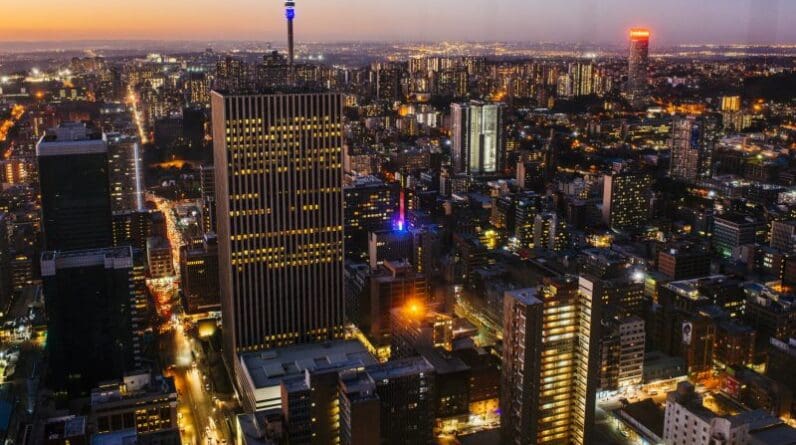
This article was written by Antony Sguazzin. It appeared first on the Bloomberg Terminal.
South Africa is facing the prospect of a breakdown in the water supply to its industrial heartland and most-populated region, adding to the woes of an economy battered by power outages, congested ports and a broken freight-rail system.
Rand Water Services Ltd., Africa’s biggest bulk-water supplier, on March 16 told three municipalities in the central Gauteng province — Johannesburg, Tshwane and Ekurhuleni, which have a combined population of more than 13 million people — that its system was on the verge of collapse.
The warning comes after a large swath of Johannesburg, South Africa’s largest city, was left without water for as long as 11 days, with some areas still without supply after lightning hit a pump station. That station was struck again on Monday night, knocking out power for a few hours and affecting eight water towers and reservoirs.
“Rand Water systems are under severe pressure,” the City of Tshwane, which includes the capital Pretoria, said in a statement. “The entire water supply system, which we share, is under strain.”
Like South Africa’s power plants and transport networks, the country’s water-supply systems have deteriorated because of inadequate maintenance, a lack of planning for population growth, mismanagement, corruption and political infighting. Johannesburg Water Management Ltd., which distributes water in the city, loses 44% of the volume supplied to it to leaks and theft.
“The more that Rand Water pumps into this leaking sieve, the more they are depleting their reservoirs,” said Anthony Turton, a professor at the Centre for Environmental Management at South Africa’s University of the Free State. “The system is now starting to self destruct.”
Rand Water’s reservoirs have drained to about 30% full since the end of December, from more than 70%. Usage by the three main metropolitan areas has surged to about 3.4 billion liters a day, its highest in at least six months, with a prolonged spell of hot weather up driving up volumes.
In total, the utility can supply more than 4.6 billion liters daily — it also serves a number of smaller municipalities as well as users in three other provinces — covering an area of more than 18,000 square kilometers (6,950 square miles).
“Municipalities consume more water than the agreed amount allocated to them,” it said in a response to queries. “Rand Water convened a meeting over the weekend to discuss amongst other things, consumption in the three metros.”
Data released by Rand Water on Tuesday shows that Ekurhuleni is consuming more than 80% more than it has been allocated, Johannesburg is using 61% more than it’s permitted to and Tshwane is 63% above its allocation.
Johannesburg Water uses its budget as “efficiently and effectively as possible” and is working to cut water usage, Nombuso Shabalala, the company’s spokeswoman, said in a response to queries. The city’s power utility and Rand Water were to blame for the recent outages, she said.
Interruptions to water supply to mines and factories are threatening economic activity, Busi Mavuso, the chief executive officer of lobby group Business Leadership South Africa, said in a March 10 column.
“We understand the challenges that both entities are facing,” Kabelo Gwamanda, Johannesburg’s mayor, told 702 Talk Radio in an interview in which he dismissed criticism of the city’s struggle to supply sufficient water. “It has always been an issue of overconsumption.”
With national elections just over two months away, the water shortage has become a political crisis, with officials and utilities shifting blame over an issue that has angered voters.
Gwamanda is Johannesburg’s seventh mayor since Dec. 2019, his appointment emblematic of the infighting and constantly changing coalitions that critics say have crippled management of the city. He is a member of the Al Jama-ah party that holds 3 of the 270 seats in the city council, and was appointed because larger parties couldn’t agree on an alternate candidate.
“There are really serious management capacity problems,” said Mike Muller, a water consultant and former director-general of South Africa’s Department of Water and Sanitation. “It’s not a supply crisis. There is real weakness in the municipalities.”
A systems update issued by Johannesburg Water on Monday listed a number of “critically low” reservoirs and areas with little or no supply. In a statement earlier this month, Rand Water said it’s owed more than 3 billion rand ($158 million) by municipalities that haven’t paid their bills.
“There has been 10 years of neglect, not putting the funding in place required for maintenance,” said Ferrial Adam, manager of the water program at the Organisation Undoing Tax Abuse, a nonprofit group focused on exposing corruption.
Repairs to a pipe that burst and cut off supply to several suburbs in northern Johannesburg earlier this month were first delayed by a shortage of welders and then by a lack of diesel they needed to run their equipment, according to a local city councilor.
Gwamanda has also faced criticism after it emerged that an inexplicably closed valve prevented water from flowing into parts of the city from Rand Water, delaying the restoration of services.
“The system is now at breaking point,” Adam said.







